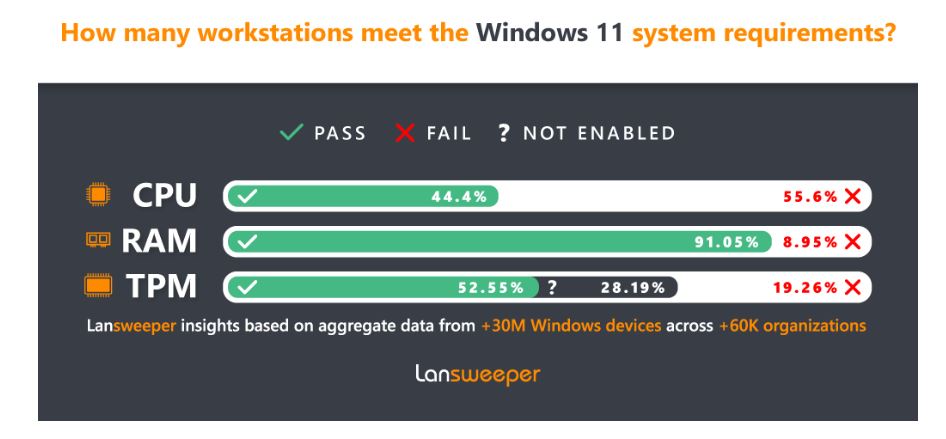Here’s an interesting data set to ponder. Belgium-based IT Asset Management (ITAM) company LANSweeper has posted survey results. It’s based on 60,000+ organizations with over 30M PCs at work. Essentially, they’ve checked those PCs’ configurations against the Windows 11 requirements. And their business PC Survey sez under half are Windows 11 ready. The lead-in graphic comes from their Windows 11 Readiness Check story and sums things up pretty nicely.
More from Business PC Survey Sez under Half Are Windows 11 Ready
The graphic shows the results of running a published script against what must be the company’s installed based of customer PCs. Essentially, it queries each machine to check its standing against Microsoft’s stated list of Windows 11 requirements.
The graphic correctly calls out some of the key elements to show that for:
- CPU 44.4% comply with requirements, 55.6% do not
- RAM 91.05% comply, 8.95% do not
- TPM 52.55% comply, 28.19% are iffy or unknown, and 19.26% do not
This is a math situation where the item with the lowest compliance rate sets the bar. Thus, it’s kosher for LANSweeper to claim that less than half of PCs meet requirements, based on the CPU survey results.
How Representative Is This Sample?
Good question! LANSweeper is more or less mum on the sources of their data, and the kinds of organizations their survey results cover. That said, there’s enough data there to be worth something, even if that something is not completely clear.
Here’s what those results tell me:
- Around half of PCs surveyed make the cut
- Most fail to meet requirements because of CPU and TPM status
- Windows 10 is therefore likely to remain a predominant business platform for another year or two, at least, if not longer
As I’ve said before, businesses tend to trail the leading/bleeding edge of Windows releases as a matter of policy and best practice. Thus, it’s unusual for companies to jump on new OS releases sooner than 12 months after initial GA. It’s more likely, in fact, for companies to trail 24-36 months behind that initial release date in taking a new OS to production.
All kinds of good reasons for delay are involved, These include planning, upgrading existing apps or replacing them with new apps, testing, staging, and deployment. In this case, Windows 11 requirements add a compulsory hardware refresh to what could be half the PCs in a typical organization’s installed base.
If anything, Windows 11 requirements will probably slow down typical adoption rates and delays. Why? Because it takes time, and costs money, to throw a hardware refresh into the typical OS migration mix. Time will tell, and I’ll keep watching. Stay tuned: I’ll keep you posted…
Thanks WinAero/Tarias B!
Here’s a shout-out to Taria Buria at WinAero.com. I saw his story “A survey reveals almost half of professional PCs are not ready for Windows 11.” It pointed me to the LANSweeper survey and its ever-so-interesting results. Bolshoye spacibo!
